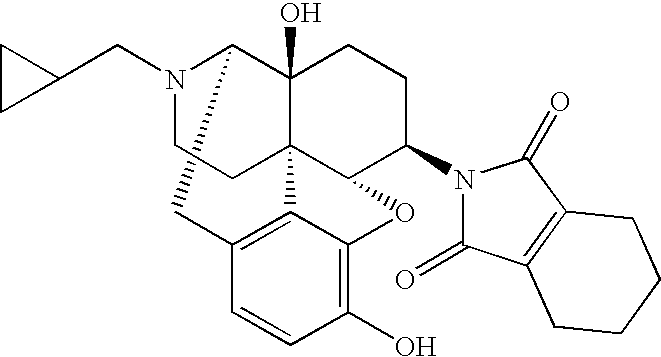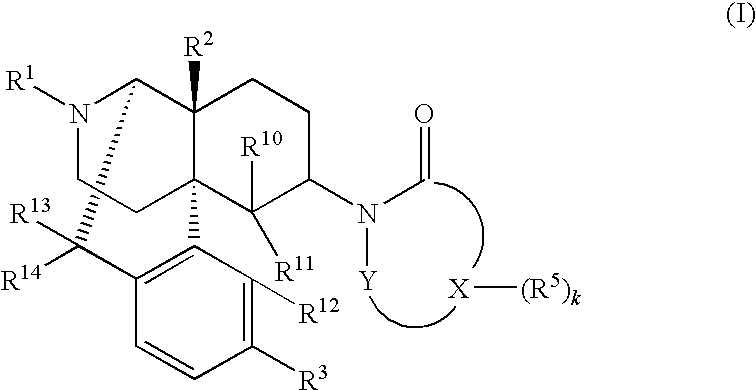Antitussive Agent
a technology of anti-tussive agent and anti-colic, which is applied in the field of anti-colic agent, can solve the problems of dependence, drug abuse, and inability to induce a sufficient anti-tussive effect, and achieve the effect of excellent therapeutic or prophylactic effect, and small side effects
- Summary
- Abstract
- Description
- Claims
- Application Information
AI Technical Summary
Benefits of technology
Problems solved by technology
Method used
Image
Examples
reference example 1
Synthesis of N-(17-cyclopropylmethyl-4,5α-epoxy-3,14-dihydroxy-morphinan-6β-yl)-maleimide-tartaric acid salt (Compound 6)
[0053]
[0054]In DMF (30 mL), 800 mg (2.34 mmol) of 6β-naltrexamine was dissolved, and 252 mg (2.57 mmol) of maleic anhydride and 0.48 mL (3.50 mmol) of triethylamine were added thereto, followed by stirring the resulting mixture at room temperature for one and half hours. Thereafter, 0.53 mL (8.18 mmol) of methanesulfonic acid was added and the mixture was stirred at 120° C. for 8 hours.
[0055]The reaction solution was left to cool to room temperature) and saturated aqueous sodium hydrogen carbonate solution was added to the reaction mixture, followed by extracting the resulting mixture with ethyl acetate. Organic layers were combined and washed with water and with saturated brine. The resulting mixture was dried over anhydrous magnesium sulfate and concentrated to obtain a crude product. The obtained crude product was purified by silica gel column chromatography to...
example 1
Effect on Guinea Pig Coughing Models Induced by Citric Acid
[0058]A solution of test substance, a solution of positive control substance (codeine phosphate) or the administration solvent was subcutaneously administered to 6 week-old Hartley guinea pigs at a volume of 0.1 mL / 100 g. After leaving the guinea pigs to stand for 25 minutes, they were retained in acrylic chambers for cough detection and the chambers were set to a measurement equipment. Thirty minutes after the subcutaneous administration of the test substance, the nebulizer was turned on and 100 mM citric acid solution, a cough inducer, was atomized and sprayed to the face of each guinea pig for a period of 15 minutes (velocity: 50 mm / min). A minipolygraph was used for recording, and the respiratory waveform within the period of 15 minutes was recorded. A signal when a large and acute change of flow rate compared to the respiratory waveform occurred independently was considered as a cough, and marked on the recording sheet....
example 2
[0061]Evaluation of Compound 1 was conducted in the same manner as in Example 1.
[0062]The average number of the coughing among the pathosis-induced group by spraying atomized 100 mM citric acid solution was found to be, increased to approximately 7 folds (average number of coughing: 30.8 times, n=4) of that among the pathosis-uninduced group sprayed with atomized physiological saline, which was 4.3 times (n=3), so that the establishment of the coughing model was confirmed (p<0.05: t-Test). When administering the positive control substance, codeine phosphate (10 mg / kg, s.c.), the effect for suppressing coughs by approximately 37% was confirmed (p<0.05: Welch-Test, n=3). Therefore, it was concluded that antitussive effect can be appropriately evaluated by using the above-described coughing models.
[0063]On the other hand, by administering Compound 1 (0.003 mg / kg, s.c.), the effect for suppressing coughs by approximately 50% in comparison to the cough number of the pathosis-induced grou...
PUM
| Property | Measurement | Unit |
|---|---|---|
| velocity | aaaaa | aaaaa |
| chemical structures | aaaaa | aaaaa |
| pharmaceutically acceptable acid addition | aaaaa | aaaaa |
Abstract
Description
Claims
Application Information
 Login to View More
Login to View More - R&D
- Intellectual Property
- Life Sciences
- Materials
- Tech Scout
- Unparalleled Data Quality
- Higher Quality Content
- 60% Fewer Hallucinations
Browse by: Latest US Patents, China's latest patents, Technical Efficacy Thesaurus, Application Domain, Technology Topic, Popular Technical Reports.
© 2025 PatSnap. All rights reserved.Legal|Privacy policy|Modern Slavery Act Transparency Statement|Sitemap|About US| Contact US: help@patsnap.com



